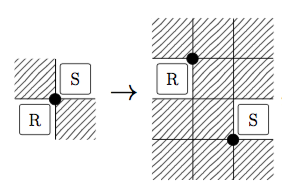 The study of permutation patterns is a very active area of research and has
connections to many other fields of mathematics as well as to computer science
and physics. One of the main questions in the field is the enumeration problem:
Given a particular set of permutations, how many permutations does the set have
of each length? The main goal of this research group is to develop a novel
algorithm which will aid researchers in finding structures in sets of
permutations and use those structures to find generating functions to enumerate
the set. Our research interests lead also into various topics in discrete
mathematics and computer science.
The study of permutation patterns is a very active area of research and has
connections to many other fields of mathematics as well as to computer science
and physics. One of the main questions in the field is the enumeration problem:
Given a particular set of permutations, how many permutations does the set have
of each length? The main goal of this research group is to develop a novel
algorithm which will aid researchers in finding structures in sets of
permutations and use those structures to find generating functions to enumerate
the set. Our research interests lead also into various topics in discrete
mathematics and computer science.
Members
-
Michael Albert, Professor, Otago University
-
Christian Bean, Lecturer, Keele University
-
Anders Claesson, Professor, University of Iceland
-
Jay Pantone, Assistant Professor, Marquette University
-
Henning Ulfarsson, Associate Professor, Reykjavik University
Current students
-
Ragnar Pall Ardal, MSc student at Reykjavik University
-
Jon Steinn Eliasson, MSc student at Reykjavik University
-
Émile Nadeau, PhD student at Reykjavik University
-
Murray Tannock, PhD student, Otago University 2017-
Recent Papers
Turning cycle restrictions into mesh patterns via Foata's fundamental transformation
Submitted • April 2023
Authors: Anders Claesson, Henning Ulfarsson
An adjacent q-cycle is a natural generalization of an adjacent transposition. We show that the number of adjacent q-cycles in a permutation maps to the sum of occurrences of two...
Pattern avoiding Motzkin paths are almost rational
Submitted • August 2021
Authors: Christian Bean, Antonio Bernini, Matteo Cervetti, Luca Ferrari
Using a recursive approach, we show that the generating function for sets of Motzkin paths avoiding a single (not necessarily consecutive) pattern is rational over x and the Catalan generating...
Automated Enumeration of Combinatorial Classes with Proof-Number Search
Submitted 2019 • September 2019
Authors: Ragnar Pall Ardal, Henning Ulfarsson, Yngvi Bjornsson
Enumerative combinatorics has traditionally been the domain of work for human mathematicians and has been applied, for instance with the probabilistic method, in computer science. One of the main problems...